#advantages of custom software development
Explore tagged Tumblr posts
Text
COTS is often developed as a commercial product by software vendors that can only be purchased and used but not customized. While bespoke software development is all about designing software to meet specific needs and is useful in the long run.
The continuous discussion over the choice of customized software or off-the-shelf software is endless. However, the decision is determined by your specific business requirements.
This blog has discussed the benefits of customized and COTS software, and the elements to consider before opting for one. I hope that helps you in making an informed decision. Visit our blogs for more helpful posts.
#Custom software development vs Off-the-shelf software#Custom software development#Off-the-shelf software#Lead Generation#Client conversion#Business needs#Pros and cons#Advantages#Software solutions#Off-the-shelf software development#COTS software development#bespoke software development#factors for customized software vs off-the-shelf software#software outsourcing
4 notes
·
View notes
Text
Custom Software vs. Off-the-Shelf Solutions: What’s Best for Your Startup?
Struggling to choose between custom software and off-the-shelf solutions for your startup? Explore the pros and cons of each option in our comprehensive guide, and discover which approach best aligns with your business goals and budget.
#advantages of custom software#advantages of off-the-shelf solutions#business process automation#business software#competitive edge software#cost of custom software#custom software#custom software advantages#custom software disadvantages#custom vs. off-the-shelf software#disadvantages of off-the-shelf solutions#hybrid software approach#integration solutions#it consulting services#it solutions for startups#off-the-shelf software benefits#off-the-shelf solutions#quick implementation software#ready-made software solutions#security in software solutions#software customization#software development for startups#software development timeframe#software scalability#startup software solutions#tailor-made software#tech trends for startups#technology stack for startups#technology strategy#proprietary software vs off the shelf software
0 notes
Text
FlutterFlow: The Right Platform to Embark Your Startup Journey

In the cut-throat competitive landscape of businesses, time to market, technology used, and profits generated are the cornerstones of defining success. The capability to implement advanced technology to innovate your business application and execute it successfully gives you a competitive edge. Traditional app development, with its daunting coding requirements and long timelines, often poses challenges for startups with an extended time to market.
Enters, low-code platforms that offer a simple solution to accelerate development without compromising on development quality. One of such platforms gaining popularity is, FlutterFlow.
Let’s explore why FlutterFlow is loved by so many startups and what it brings to the table. Before we get into the nitty-gritty of FlutterFlow, let’s dig in a little deeper to understand low-code development.
What Is Low Code Development?
Low code development refers to software development environments that let developers build applications through graphical user interfaces rather than traditional codes. The platforms reduce the amount of manual coding, which results in faster development lifecycles and easier iterations.
Benefits Of Low-Code Platforms

Rapid development and deployment speed.
Resource management with smaller development teams.
Better solutions with less coding needs
Easy to use by non-technical users, making it easier for them to contribute to the app development process.
Much easier to make changes and updates.
Thus with the ease and accessibility to even non-technical users, Low Code development is helping startups create professional applications on a budget. Some of the popular low-code platforms are Appian, Creatio, Outsystems, FlutterFlow, etc.
FlutterFlow gets a lead over others as it is taking low code development to new heights. Let’s now explore what makes FlutterFlow a perfect platform for your startup.
What is FlutterFlow?
FlutterFlow is built on Google’s Flutter framework, designed for developing cross-platform applications for Android, iOS, and the web. It offers a visual design interface, allowing users to plan app layouts effortlessly through simple drag-and-drop capability. FlutterFlow helps real-time collaboration, making it best for teams working together on a development project.
With an easy-to-use interface, no technical skills, and a strong framework to back it, FlutterFlow has been gaining popularity since it was conceived. Whether you are a startup or a small-scale business, if you want to create a mobile application that resonates with your audience, then, choose the FlutterFlow platform and let things flow.
Why FlutterFlow Is Perfect for Startups?
FlutterFlow is taking low code development to new heights by offering a visual development environment where users can build the solutions they want without compromising on app feature quality.
FlutterFlow basically incorporates and promotes best practices for software development. The platform streamlines complex IDE tasks into an intuitive UI, making developer interactions easier. To use the platform one needs basic training, thus even non-developers get into the basics of core app development concepts.
FlutterFlow entered the market with a vision to go from low code development to visual development. Here’s how the team is planning to achieve their goals:
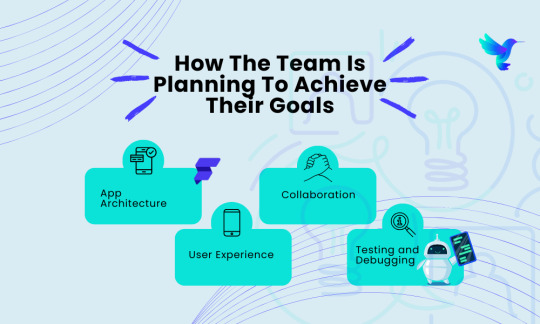
App Architecture: The codes generated using FlutterFlow meet the standards set by Flutter and Dart. They abide by the standard app market, thus helping users with a credible app development solution.
Testing and Debugging: The developers can simply test and debug the applications by running, testing, and resolving issues. This allows startups to enter the market with a flawless and highly rewarding application.
Collaboration: With modular development, smart version controls, and comprehensive access management, users can collaborate easily for better results.
User Experience: With an easy-to-explore interface, edit on clicks, ensure consistency, incorporate AI where possible, and users can switch between code and GUI.
FlutterFlow offers startups an environment where they can cross-operate, collaborate, and discuss their problems. The platform is conceived to make development easier, more convenient, and accessible for non-tech people also, who can easily make their contribution to the web now!
Some of the other advantages of the platform are:
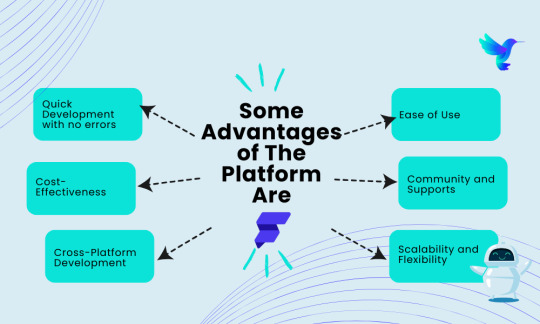
1. Quick Development With No Errors
The cheat code to making the best of your business is, to enter the market ASAP.
One of the most significant benefits of FlutterFlow is the speed at which the projects may develop. The platform’s visual interface and pre-built elements allow for speedy prototyping and development. Startups can fast-build minimum viable products (MVPs) to check thoughts in the marketplace without making a heavy investment in development sources.
Thus, you can create a product faster, take it to the market, and get feedback easily. We understand not every product works well on the first go, but with FlutterFlow you get the ease of making iterations and offering your audience a solution they’d appreciate.
2. Cost-Effectiveness
Most startups run on budget constraints. FlutterFlow helps reduce investing in large teams of seasoned developers. The platform’s drag-and-drop capability and pre-built templates lessen the quantity of custom code required, which translates to lower support and maintenance fees. A developer with lesser experience and understanding of the development languages can also, easily create an app here making it easier for you to invest your funds in other business verticals too.
3. Cross-Platform Development
FlutterFlow’s foundation lies at the Flutter framework which guarantees that applications are cross-platform by default. Thus by picking FlutterFlow startups can create and deploy applications to iOS, Android, and net platforms simultaneously. This cross-platform functionality is crucial for startups looking to maximize their target audience and digital presence without incurring the expenses and complexities of keeping separate codebases for specific platforms.
4. Ease Of Use
FlutterFlow is designed to be user-friendly, making it accessible to both skilled app developers and those with limited coding exposure. This democratization of app development means that non-technical founders and team members can contribute to the development procedure. FlutterFlow also gives tremendous documentation and tutorials, further decreasing the barrier to entry.
Because it is easy to use, the startup founders can make changes to the product as they want.
5. Scalability And Flexibility
Despite being a low-code platform, FlutterFlow gives massive flexibility. Users can add custom code to increase the functionality of their programs, making sure that they are now not confined with the aid of the platform’s built-in features. FlutterFlow additionally integrates seamlessly with backend services like Firebase and Supabase, bearing in mind robust and scalable backend solutions.
6. Community And Support
Being part of the Flutter ecosystem, FlutterFlow advantages from an active and supportive community. This network affords a wealth of assets, tutorials, and discussions that could assist startups conquer challenges and make the most of the platform. Additionally, FlutterFlow is continually evolving, with new capabilities and improvements being brought often based on user comments.
New users can always connect with the community for any assistance and customization thus creating a growth-oriented and learning ecosystem.
These are some of the most popular reasons why FlutterFlow is one of the most prominent low-code platforms for startups. So, if you are aiming to start your entrepreneurial journey and aren’t sure how to start without investing much in development, FlutterFlow is your trusted development partner.
Addressing Common Concerns of Using FlutterFlow

FlutterFlow may offer a great advantage for startups and businesses, but it does come with some limitations. Let’s explore the common concerns when working on the platform.
Customization Limits
The most common and often-faced concern with low-code platforms is the potential difficulty of customization. However, FlutterFlow mitigates this with the aid of custom code integration. This ensures that whilst you can enjoy the speed and efficiency of low-code development, you still have the flexibility to put into effect custom functions as wanted.
Scalability
Another concern is scalability. FlutterFlow is designed to handle significant user load and great data volumes through its integration with a powerful backend. Startups can hopefully scale their packages as their customer base expands, knowing that the platform is designed and developed to meet their business needs.
Startups with a limited user base can use the capabilities of FlutterFlow for future preparedness.
Learning Curve
While FlutterFlow is user-friendly, there can still be a strong learning curve, specifically for those new to app development. However, the considerable assets available, together with documentation, tutorials, and network help, assist mitigate this challenge.
Startups can always seek assistance from other development agencies experienced in FlutterFlow to boost learning and make sure first-class practices are followed. With little time and dedication, one can excel in their skills and implement them to build innovative products for the future.
Conclusion
FlutterFlow represents a tremendous advancement in the realm of low-code development systems, particularly for startups. Its combination of speed, value-effectiveness, ease of use, and flexibility makes it a super choice for early-stage businesses seeking to deliver their thoughts to the marketplace. By leveraging FlutterFlow, startups can reduce development time and fees, build cross-platform applications, and remain agile in a competitive landscape.
For startups and small-scale organizations trying to maximize their assets and boost their development process, FlutterFlow offers a compelling solution that bridges the gap between rapid prototyping and strong, scalable app development. As the platform continues to evolve and improve, it’s far poised to end up a good extra effective device for startups aiming to innovate and be triumphant in the virtual age.
#FlutterFlow#Custom App Development#FlutterFlow Startup businesses#Challenges for startups businesses#Low Code Development#graphical user interfaces#Benefits Of Low-Code Platforms#Google’s Flutter framework#cross-platform applications#Hire Flutter Developers#software development#advantage for startups and businesses
0 notes
Text
#app development#ai development#software development#india best custome software devlopment agency#custome mobile app devlopment#mobile app development#advantages of custome software
0 notes
Text
Which benefits come with developing custom software?
Custom software development offers several advantages compared to off-the-shelf solutions. Here are some key benefits:

Tailored to Specific Needs:
Custom software is designed to meet the unique requirements of a business. This ensures that the software aligns perfectly with the company’s processes, workflows, and objectives.
Scalability:
Custom solutions can be easily scaled to accommodate growing business needs. As the organization expands, the software can be updated and enhanced to support increased data volumes, users, and functionalities.
Optimized Performance:
Custom software is built with the specific infrastructure and technology stack in mind, allowing developers to optimize performance based on the organization’s requirements. This can result in faster processing times and better overall efficiency.
Integration with Existing Systems:
Custom software can be seamlessly integrated with existing systems and applications. This integration streamlines business processes, eliminates data silos, and improves overall efficiency.
Cost Efficiency in the Long Run:
While the upfront costs of custom software development may be higher than purchasing off-the-shelf solutions, the long-term cost of ownership can be lower. Custom software is built to last, reducing the need for frequent updates, licenses, and additional features that may be unnecessary.
Security:
Security is a critical consideration for businesses, especially those handling sensitive data. Custom software allows for the implementation of robust security measures tailored to the specific needs of the organization, reducing vulnerabilities and enhancing data protection.
Ownership and Control:
With custom software, businesses have complete ownership and control over the source code. This means they can make changes, updates, and modifications as needed without being dependent on third-party vendors.
Competitive Advantage:
Custom software can provide a competitive edge by offering unique features and functionalities that are not available in off-the-shelf solutions. This differentiation can help businesses stand out in the market.
Adaptability to Industry Changes:
Industries evolve, and businesses need software that can adapt to these changes. Custom solutions are more flexible and can be easily modified to accommodate shifts in industry regulations, market trends, or internal processes.
Support and Maintenance:
Custom software development often comes with dedicated support and maintenance services. This ensures that any issues can be addressed promptly, and updates can be implemented as needed to keep the software running smoothly.
While custom software development services have their advantages, it’s important to note that it require careful planning, skilled development teams, and effective project management to achieve success.
0 notes
Text
DAY 6274
Jalsa, Mumbai Aopr 20, 2025 Sun 11:17 pm
🪔 ,
April 21 .. birthday greetings and happiness to Ef Mousumi Biswas .. and Ef Arijit Bhattacharya from Kolkata .. 🙏🏽❤️🚩.. the wishes from the Ef family continue with warmth .. and love 🌺
The AI debate became the topic of discussion on the dining table ad there were many potent points raised - bith positive and a little indifferent ..
The young acknowledged it with reason and able argument .. some of the mid elders disagreed mildly .. and the end was kind of neutral ..
Blessed be they of the next GEN .. their minds are sorted out well in advance .. and why not .. we shall not be around till time in advance , but they and their progeny shall .. as has been the norm through generations ...
The IPL is now the greatest attraction throughout the day .. particularly on the Sunday, for the two on the day .. and there is never a debate on that ..
🤣
.. and I am most appreciative to read the comments from the Ef on the topic of the day - AI .. appreciative because some of the reactions and texts are valid and interesting to know .. the aspect expressed in all has a legitimate argument and that is most healthy ..
I am happy that we could all react to the Blog contents in the manner they have done .. my gratitude .. such a joy to get different views , valid and meaningful ..
And it is not the end of the day or the debate .. some impressions of the Gen X and some from the just passed Gen .. and some that were never ever the Gen are interesting as well :
The Printing Press (15th Century)
Fear: Scribes, monks, and elites thought it would destroy the value of knowledge, lead to mass misinformation, and eliminate jobs. Reality: It democratized knowledge, spurred the Renaissance and Reformation, and created entirely new industries—publishing, journalism, and education.
⸻
Industrial Revolution (18th–19th Century)
Fear: Machines would replace all human labor. The Luddites famously destroyed machinery in protest. Reality: Some manual labor jobs were displaced, but the economy exploded with new roles in manufacturing, logistics, engineering, and management. Overall employment and productivity soared.
⸻
Automobiles (Early 20th Century)
Fear: People feared job losses for carriage makers, stable hands, and horseshoe smiths. Cities worried about traffic, accidents, and social decay. Reality: The car industry became one of the largest employers in the world. It reshaped economies, enabled suburbia, and created new sectors like travel, road infrastructure, and auto repair.
⸻
Personal Computers (1980s)
Fear: Office workers would be replaced by machines; people worried about becoming obsolete. Reality: Computers made work faster and created entire industries: IT, software development, cybersecurity, and tech support. It transformed how we live and work.
⸻
The Internet (1990s)
Fear: It would destroy jobs in retail, publishing, and communication. Some thought it would unravel social order. Reality: E-commerce, digital marketing, remote work, and the creator economy now thrive. It connected the world and opened new opportunities.
⸻
ATMs (1970s–80s)
Fear: Bank tellers would lose their jobs en masse. Reality: ATMs handled routine tasks, but banks actually hired more tellers for customer service roles as they opened more branches thanks to reduced transaction costs.
⸻
Robotics & Automation (Factory work, 20th century–today)
Fear: Mass unemployment in factories. Reality: While some jobs shifted or ended, others evolved—robot maintenance, programming, design. Productivity gains created new jobs elsewhere.
The fear is not for losing jobs. It is the compromise of intellectual property and use without compensation. This case is slightly different.
I think AI will only make humans smarter. If we use it to our advantage.
That’s been happening for the last 10 years anyway
Not something new
You can’t control that in this day and age
YouTube & User-Generated Content (mid-2000s onward)
Initial Fear: When YouTube exploded, many in the entertainment industry panicked. The fear was that copyrighted material—music, TV clips, movies—would be shared freely without compensation. Creators and rights holders worried their content would be pirated, devalued, and that they’d lose control over distribution.
What Actually Happened: YouTube evolved to protect IP and monetize it through systems like Content ID, which allows rights holders to:
Automatically detect when their content is used
Choose to block, track, or monetize that usage
Earn revenue from ads run on videos using their IP (even when others post it)
Instead of wiping out creators or studios, it became a massive revenue stream—especially for musicians, media companies, and creators. Entire business models emerged around fair use, remixes, and reactions—with compensation built in.
Key Shift: The system went from “piracy risk” to “profit partner,” by embracing tech that recognized and enforced IP rights at scale.
This lead to higher profits and more money for owners and content btw
You just have to restructure the compensation laws and rewrite contracts
It’s only going to benefit artists in the long run
Yes
They can IP it
That is the hope
It’s the spread of your content and material without you putting a penny towards it
Cannot blindly sign off everything in contracts anymore. Has to be a lot more specific.
Yes that’s for sure
“Automation hasn’t erased jobs—it’s changed where human effort goes.”
Another good one is “hard work beats talent when talent stops working hard”
Which has absolutely nothing to with AI right now but 🤣
These ladies and Gentlemen of the Ef jury are various conversational opinions on AI .. I am merely pasting them for a view and an opinion ..
And among all the brouhaha about AI .. we simply forgot the Sunday well wishers .. and so ..














my love and the length be of immense .. pardon

Amitabh Bachchan
107 notes
·
View notes
Text
I got a Steam Deck last year, and it’s such a great machine. It’s obviously inspired by Nintendo Switch, but it’s a lot better than a Switch.
The most important part is that it runs PC games. It’s fundamentally a Linux gaming PC in the form of a handheld console. There are a lot more games available than any console and and PC games both on Steam and GOG are a lot cheaper than console ones. You can get old or indie games for as cheap as 1-3 euro during sales. It’s a tremendous advantage for the deck over its console competitors.
And while the obvious intent of the deck is to get more people to buy games from Steam, it isn’t a walled garden at all. The deck launches into Steam when you boot it up, but you can go into desktop mode, and then it functions as a normal PC running a Linux distro. From there you can install Lutris or Heroic Games Launcher, and use it to easily install games you bought from GOG and Itch.io.
You can also do things like use the official dock or an unofficial usb-c hub to hook the deck up to a monitor, mouse and keyboard to use it as a desktop PC. Or you can hook it up to a tv to use it as home console.
The hardware is also a lot more powerful than a switch, the demanding triple-a games it can play is actually impressive. Although this comes with the natural disadvantage that it’s bulkier too. Putting more powerful PC parts demands more space for them. The deck is not something I bring with me outside. But then again I didn’t even do that with the 3DS, which was actually of a practical size to do that. The deck is portable enough that I can comfortably play lying in bed, which is how I always used my handheld consoles. So it’s perfect for me, but maybe not if you want to play it on the bus or something. It can probably be a fun addition to your luggage on longer trips though.
Of course, as mentioned, the Steam Deck uses Linux. This has both advantages and disadvantages. The main advantage is that it allows Valve to customize the operating system to make it fit with the machine it’s running on. The Deck’s SteamOS feels really well-integrated into the hardware, like how a proper console OS should be like. It’s not that dissimilar to how Sony used FreeBSD to make Playstation’s OS. Windows would not allow for this amount of customization and would not integrate as well.
And the open source nature of most Linux development allows Valve and the user to use existing open-source Linux software to their advantage. For example, the desktop mode is largely not a Valve creation, it’s an existing desktop environment for Linux, KDE Plasma. Yet it extends what the user can do with the deck to a great extent, like for installing non-steam games.
The main disadvantage to the Deck using Linux is that most PC games are built for Windows and don’t run natively under Linux. To run games built for Windows, the Deck has to run it through Proton, a compatibility layer which is Valve’s own gaming-focused version of Wine. Wine/Proton is far from perfect, sometimes games require extensive tinkering to work, or only run with serious issues, or don’t run at all, no matter what you do. Sometimes a game not working with Wine due to some random but serious issue that comes naturally from running a Windows executable on a Linux system via a compatibility layer. Sometimes it’s due to things like a multiplayer’s game anti-cheat system requiring access to the Windows kernel, and it will block a Linux pc from running the game because it has no Windows kernel.
This is however not as big a problem as it might otherwise be. Most games work, more or less. Valve has put a lot of work and money into both their own Proton and the Wine project as a whole, and they work a lot better than they did 10 years ago. Many run perfectly out of the box, because they are native, or play nice with Proton. Some require mere minor tinkering, like using a different version of Proton. And I generally don’t play multiplayer games, or if I do they don’t have draconian anti-cheats, so the games that are blocked because of anti-cheat are no big loss to me. The Steam Deck not running Fortnite is a plus in my book.
And we shouldn’t forget the Steam Deck verified system. Basically Valve employees check if the game runs out of the box with no issues on the Deck. They get a verified rating if they work with no issue, including both proton compatibility but also things like the controls working nice and the text being legible on the deck’s small screen. They also get a “playable” rating if the game runs to an acceptable standard but with tinkering required or other minor issues.
This is a good system. If you dislike tinkering, you can just buy and play games on steam with a verified rating, and the deck will work like a normal console for you, but with a lot cheaper games. It’s a good way to get people used to consoles into PC gaming, which is probably the point of the Deck.
And if you want more than deck verified games from Steam on the Deck, you are given the freedom to do it. I’ve gotten officially non-supported steam games to run on the deck by installing and using proton-GE and I’ve installed and played games from GOG.
The Steam Deck is really how a Linux PC for the common people should work. An easy and slick experience for casual users, but freedom and customization given to those that want it.
82 notes
·
View notes
Text
So this is part 2 of this post, if yall wanna give it a read for context.
In this post, I’ll be talking about how Color’s physical disability of having only one eye would influence how he interacts with his special interests in photography and travel.
As well as how his PTSD, autism, chronic fatigue, and separation anxiety from Killer could also affect things.
With one eye, Color might have reduced depth perception, which could make it challenging to gauge distances accurately. He might rely more on autofocus features, practice to enhance his spatial awareness, or use techniques like focus stacking for precise shots.
He might prefer using cameras with electronic viewfinders (EVF) or live view screens rather than optical viewfinders, which could be more challenging to use with one eye. Adjusting camera settings and composing shots via a larger display would be easier.
He might develop unique framing and composition techniques, leveraging his perspective creatively. Color could take extra time to ensure his shots are well-composed, possibly using grid overlays or other aids to help with alignment.
Customizing camera gear to suit his needs, such as using tripods, stabilizers, or remote controls, to help steady the camera and compose shots more comfortably.
He might spend additional time in post-processing to correct any minor misalignments or issues that arise from the reduced depth perception during the shooting process.
For travel, navigating unfamiliar places might require more caution, especially in crowded or complex environments. He might use mobility aids, rely on GPS and mapping apps, or travel with companions to ensure safety.
Color could engage in meticulous planning to minimize unexpected challenges, such as researching accessible routes, accommodations, and transportation options.
Color might use his experiences and perspective to connect with others, sharing how his disability influences his travel and photography, fostering understanding and empathy.
Developing strategies to cope with the physical demands of travel, such as pacing himself, taking regular breaks, and prioritizing destinations or activities that are less physically demanding.
His unique perspective could inspire him to create compelling stories or advocacy pieces about accessibility in travel and photography, raising awareness and inspiring others with disabilities.
Embracing his distinct view of the world, his photography could offer unique perspectives that stand out, turning his perceived limitation into an artistic advantage.
He might become involved in communities focused on accessible travel and photography, sharing tips, experiences, and inspiring others with similar challenges.
Autism and chronic fatigue would likely significantly impact Color’s ability to engage with his special interests in photography and travel.
In photography, chronic fatigue would necessitate careful energy management. Color might plan shorter, more focused photography sessions and prioritize rest to avoid burnout.
Streamlining his workflow, from setting up equipment to post-processing, to conserve energy. This could include using presets in editing software or organizing his gear for easy access.
He could chose photography locations that are easily accessible and require minimal physical exertion. He might also prefer locations close to home or base to reduce travel time and energy expenditure.
He would likely use ightweight equipment to reduce physical strain, possibly investing in high-quality but compact cameras and lenses. He might also use monopods or lightweight tripods for additional support.
Autism can come with sensory sensitivities. Color might choose quieter, less crowded locations for photography and use noise-canceling headphones or other tools to manage sensory overload.
With travel, he’d have to pace himself. Planning travel with built-in downtime to rest and recharge. He might avoid overly ambitious itineraries and allow for flexible scheduling to accommodate his energy levels.
He’d probably chose ccommodations that are comfortable, quiet, and accessible, ensuring he has a safe space to retreat to when needed.
He’d prefer modes of transportation that offer comfort and minimal stress, such as direct flights, train travel, or driving. He might also opt for private or semi-private tours to control the pace and environment.
Keeping up with healthcare needs, including regular check-ups, medication management, and any necessary accommodations. He might also carry a travel health kit tailored to his specific needs.
He’d combine photography with travel in a way that maximizes enjoyment and minimizes strain. For example, he might focus on travel photography during the golden hours (early morning and late afternoon) when conditions are optimal, and the rest of the day can be used for rest.
Creating content that reflects his experiences with autism and chronic fatigue, such as blogs, vlogs, or social media posts. This can help raise awareness and provide valuable insights to others with similar challenges.
Engaging with communities of autistic travelers and photographers to share experiences, tips, and support. This can provide a sense of camaraderie and practical advice tailored to his needs.
Establishing routines that provide predictability and reduce stress. This might include having a consistent photography and travel routine, preparing for trips well in advance, and creating checklists.
Practicing mindfulness or relaxation techniques to manage stress and sensory overload. This can help maintain focus and calm, particularly in challenging environments.
Utilizing assistive technologies, such as apps for energy tracking, sensory-friendly gear, or digital tools that aid in planning and organization.
Color’s PTSD from solitary confinement and isolation in the Void, combined with his separation anxiety towards Killer, can create a complex situation that both challenges and shapes his engagement in traveling and photography.
Color’s need to stay on the move due to PTSD makes traveling appealing, as it provides a sense of freedom and escape from confinement. However, this constant movement could also become exhausting and anxiety-inducing if it lacks purpose or stability.
His separation anxiety towards Killer might lead him to seek Killer’s company while traveling. Traveling with Killer could provide a sense of security and reduce his anxiety, but it also means his travel plans would need to align with Killer’s availability and willingness to join him.
Color might need to carefully plan his travels to ensure he has safe and familiar places to stay, reducing the unpredictability that could trigger his PTSD. Having a structured itinerary could help him feel more in control and less anxious.
Traveling to new and unfamiliar places might sometimes trigger memories of his isolation, especially if he encounters situations that remind him of the Void. He would need to find a balance between exploring new places and ensuring his mental well-being.
Photography could serve as a therapeutic outlet, allowing Color to process and express his emotions through capturing images. It might help him make sense of his experiences and provide a way to externalize his trauma.
Color might be drawn to photographing subjects that reflect his internal state or provide a sense of solace. He could focus on themes like freedom, movement, and connection, finding meaning and healing in his work.
Having Killer around while engaging in photography could provide comfort and reduce his anxiety. Killer might even become a frequent subject in Color’s photos, symbolizing their bond and mutual support.
Color might need to develop strategies to manage his anxiety while photographing, such as taking breaks, grounding exercises, or having a trusted companion like Killer present. This would help him stay focused and engaged in his special interest.
The mutual separation anxiety between Color and Killer could strengthen their bond, as they rely on each other for emotional support. This bond could provide Color with the stability he needs to engage in his interests.
Color would need to balance his need for movement and exploration with Killer’s needs and limitations. They might develop a mutual understanding and compromise, ensuring both their well-being while pursuing their interests.
Color might prefer traveling to places where he can easily find comfort and familiarity, such as visiting friends or known locations. This reduces the stress of the unknown and helps him stay grounded.
Establishing routines or rituals while traveling and photographing can provide a sense of stability. For example, always starting the day with a specific activity or having regular check-ins with Killer can help Color manage his anxiety.
They might have frequent phone calls if Killer ever can’t join Color on his travels, at particular times of the day.
I can see Color sticking to this routine at the exact time and getting anxious and worried if Killer doesn’t call or pick up, which is likely to happen at some point simply because he has memory issues and sticking to routine is hard for him. But Color, at least for a bit, is likely to assume the worse.
Color might also keep a photograph of him and all his friends close by on his person. (I also like to think that Delta made his camera, he keeps some of Beta’s drawings with him, and also he’s memorized the recipe for Epic’s chocolate cookies.)
If he and Killer have already had their wedding by this point, he’d likely keep his ring close and near. Perhaps kissing it before bed, and fidgeting with it becomes a new comforting stim.
Over time, engaging in his special interests despite his PTSD and anxiety can help Color build resilience. Each successful trip or photography session can boost his confidence and reinforce his ability to cope with challenges.
Color might find deeper meaning in his travels and photography by using them as tools for healing and connection. Documenting his journey and sharing it with others can create a sense of purpose and community.
#utmv headcanons#color spectrum duo#colorkiller#color sans#colour sans#color!sans#killer sans#utmv#sans au#sans aus#killer!sans#killertale#othertale#othertale sans#other sans#undertale#autistic headcanon#utmv hc#undertale au#undertale aus#undertale multiverse#epic sanses#bad sanses#bad sans gang#< for reach#killercolor#undertale something new#epic!sans#delta!sans#cross!sans
39 notes
·
View notes
Text
AGARTHA Aİ - DEVASA+ (4)

In an era where technology and creativity intertwine, AI design is revolutionizing the way we conceptualize and create across various industries. From the runway to retail, 3D fashion design is pushing boundaries, enabling designers to craft intricate garments with unparalleled precision. Likewise, 3D product design is transforming everything from gadgets to furniture, allowing for rapid prototyping and innovation. As we explore these exciting advancements, platforms like Agartha.ai are leading the charge in harnessing artificial intelligence to streamline the design process and inspire new ideas.
AI design
Artificial intelligence (AI) has revolutionized numerous industries, and the realm of design is no exception. By leveraging the power of machine learning and advanced algorithms, AI is transforming the way designers create, innovate, and deliver their products. AI-driven tools enable designers to harness vast amounts of data, allowing for more informed decision-making and streamlined workflows.
In the context of graphic design, AI can assist artists in generating ideas, creating unique visuals, and even automating repetitive tasks. For instance, programs powered by AI design can analyze trends and consumer preferences, producing designs that resonate with target audiences more effectively than traditional methods. This shift not only enhances creativity but also enables designers to focus on strategic thinking and ideation.
Moreover, AI is facilitating personalized design experiences. With the help of algorithms that analyze user behavior, products can be tailored to meet the specific needs and tastes of individuals. This level of customization fosters deeper connections between brands and consumers, ultimately driving customer satisfaction and loyalty in an increasingly competitive market.
3D fashion design
In recent years, 3D fashion design has revolutionized the way we create and visualize clothing. Using advanced software and tools, designers can create lifelike virtual garments that allow for innovative experimentation without the need for physical fabric. This trend has not only streamlined the design process but has also significantly reduced waste in the fashion industry.
Moreover, 3D fashion design enables designers to showcase their creations in a more interactive manner. By utilizing 3D modeling and rendering technologies, designers can present their collections in virtual environments, making it easier for clients and consumers to appreciate the nuances of each piece. This immersive experience also helps in gathering valuable feedback before producing the final product.
Furthermore, the integration of 3D fashion design with augmented reality (AR) and virtual reality (VR) technologies is bringing a fresh perspective to the industry. Consumers can virtually try on clothes from the comfort of their homes, thereby enhancing the shopping experience. As this field continues to evolve, it promises to bridge the gap between creativity and technology, paving the way for a sustainable and forward-thinking fashion future.
3D product design
3D product design has revolutionized the way we conceptualize and create products. With advanced software tools and technologies, designers can now create highly detailed and realistic prototypes that are not only visually appealing but also functional. This process allows for a quicker iteration of ideas, enabling designers to experiment with various styles and functionalities before arriving at the final design.
One of the significant advantages of 3D product design is the ability to visualize products in a virtual environment. Designers can see how their creations would look in real life, which is essential for understanding aesthetics and usability. Additionally, this technology enables manufacturers to identify potential issues in the design phase, reducing costs associated with prototype development and rework.
Moreover, the rise of 3D printing has further enhanced the significance of 3D product design. Designers can swiftly turn their digital models into tangible products, allowing for rapid prototyping and small-batch manufacturing. This agility not only speeds up the time-to-market for new products but also paves the way for more innovative designs that were previously impossible to execute.
Agartha.ai
Agartha.ai is a revolutionary platform that merges artificial intelligence with innovative design, creating a new avenue for designers and creators alike. With the rapid advancements in technology, Agartha.ai leverages AI to streamline various design processes, enabling users to produce unique and captivating designs with ease.
The platform provides tools that empower both emerging and established designers to explore the possibilities of AI design. By utilizing intelligent algorithms, Agartha.ai can assist in generating design options, ensuring that creativity is not hindered but enhanced. This results in a more efficient workflow and allows designers to focus on the conceptual aspects of their projects.
One of the standout features of Agartha.ai is its ability to adapt to different design disciplines, such as 3D fashion design and 3D product design. By supporting a broad spectrum of design fields, it positions itself as a versatile tool that meets the evolving needs of today's creative professionals. Whether it's crafting intricate fashion pieces or developing innovative product designs, Agartha.ai is at the forefront of the design revolution.
329 notes
·
View notes
Text
BigProfitPulse.io Reviews Explore the Best Trading Conditions
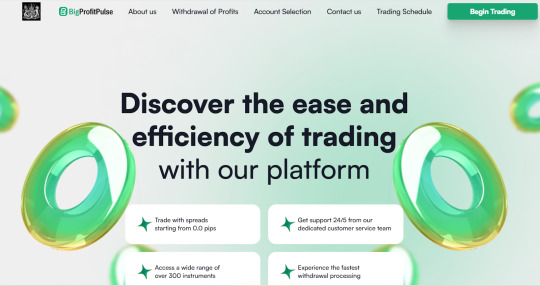
The online trading world is dynamic and ever-evolving making it crucial to choose a reliable and efficient platform that provides traders with the best opportunities. BigProfitPulse.io reviews showcase why this platform stands out as a leader in the financial industry offering a combination of innovative tools competitive trading conditions and high-speed execution. With a diverse range of financial instruments and a user-friendly interface traders can seamlessly engage in trading without unnecessary hurdles. The ability to access real-time market prices and leverage personalized support ensures that every trader from beginners to professionals can optimize their strategies and achieve financial success.
BigProfitPulse.io Reviews Why Traders Choose Us
Traders are always in search of a platform that not only meets their expectations but also exceeds them. BigProfitPulse.io reviews highlight how this platform consistently delivers top-tier trading services ensuring that every trader has access to the best possible conditions. A major reason why traders trust BigProfitPulse.io is the platform’s commitment to transparency and efficiency. With instant order execution and competitive spreads traders can capitalize on opportunities without worrying about delays or hidden fees. Additionally the platform’s training programs provide users with invaluable insights helping them refine their skills and develop well-informed trading strategies. Whether you are just getting started or already an experienced trader BigProfitPulse.io has the tools and resources to support your journey.
BigProfitPulse.io A Cutting-Edge Trading Platform
One of the most discussed features in BigProfitPulse.io reviews is its cutting-edge trading platform which is designed to cater to traders of all levels. The web-based terminal allows users to analyze financial markets track real-time price movements and execute trades effortlessly from their browsers. There is no need for additional software installations or complicated setup procedures making it easier than ever to engage in global trading. Whether you are trading stocks foreign currencies or precious metals BigProfitPulse.io provides an advanced yet accessible trading environment. The platform is equipped with the latest tools for technical analysis ensuring that traders can make data-driven decisions with confidence.

BigProfitPulse.io Reviews Comprehensive Client Support
A key highlight in BigProfitPulse.io reviews is the comprehensive customer support that ensures traders receive assistance whenever they need it. The platform prides itself on offering professional support services with a team of knowledgeable experts available to answer questions resolve technical issues and provide valuable insights. Whether traders require help navigating the trading terminal understanding market trends or optimizing their trading strategies BigProfitPulse.io’s support team is always ready to assist. This level of commitment to customer service sets the platform apart making it a preferred choice for traders looking for reliability and security.
BigProfitPulse.io Real-Time Liquidity and Instant Execution
Market conditions can change in an instant and traders need a platform that provides real-time liquidity and swift order execution. BigProfitPulse.io reviews emphasize how the platform ensures that trades are processed without delays allowing traders to take advantage of market fluctuations as they happen. The integration of interbank liquidity ensures that users get the best available prices maximizing their profitability. By eliminating execution lags and providing seamless order processing BigProfitPulse.io enhances the overall trading experience giving users a competitive edge in the financial markets.
BigProfitPulse.io Reviews Personalized Training for Traders
Education and continuous learning play a significant role in a trader’s success and BigProfitPulse.io reviews highlight how the platform offers personalized training programs to support users at every stage of their trading journey. Traders are matched with experienced tutors who provide insights into market movements risk management and profitable trading strategies. This hands-on approach helps traders develop confidence and refine their skills ensuring they can navigate financial markets with greater precision. The platform’s commitment to education makes it an ideal choice for both newcomers and seasoned professionals looking to expand their knowledge.
BigProfitPulse.io Reviews Secure and Fast Withdrawals
Security and convenience are top priorities for traders and BigProfitPulse.io reviews confirm that the platform provides a safe and efficient withdrawal process. Users can request fund withdrawals at any time knowing that transactions will be processed swiftly without unnecessary delays. The platform employs advanced security measures to protect user funds and personal data giving traders peace of mind while they focus on their trading activities. Whether traders are actively trading or cashing out their profits they can trust BigProfitPulse.io to handle their transactions smoothly and securely.
BigProfitPulse.io Getting Started is Easy
A major advantage noted in BigProfitPulse.io reviews is the simplicity of getting started on the platform. Registration is quick and straightforward allowing traders to create an account and begin trading within minutes. The low minimum deposit requirement makes it accessible to traders of all backgrounds whether they are testing the waters or fully committing to the trading lifestyle. The platform also provides personalized guidance during the onboarding process ensuring that new traders have all the necessary tools and knowledge to begin their journey with confidence.
BigProfitPulse.io The Advantages of Trading Here
Traders continue to choose BigProfitPulse.io for the numerous advantages it offers. BigProfitPulse.io reviews frequently mention the following key benefits
Competitive spreads and low trading commissions ensuring maximum profitability
Swift and hassle-free processing of withdrawal requests allowing traders to access their funds at any time
Timely updates on significant market events helping traders stay informed and make strategic decisions
Access to global financial markets enabling users to diversify their portfolios and explore multiple investment opportunities
Professional customer support dedicated to resolving issues and providing expert assistance
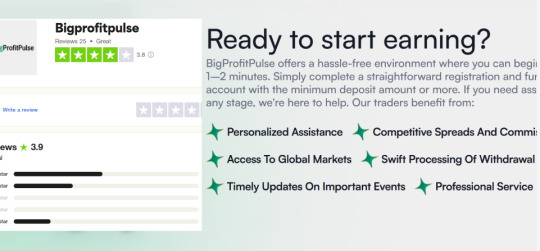
BigProfitPulse.io Reviews Your Path to Financial Success
Finding the right trading platform is essential for achieving success in the financial markets. BigProfitPulse.io reviews highlight how this platform combines advanced technology expert guidance and superior trading conditions to create an unparalleled trading experience. Whether you are an aspiring trader or a seasoned professional looking for a reliable partner BigProfitPulse.io provides all the tools and resources necessary for success. By choosing BigProfitPulse.io traders gain access to a secure transparent and innovative trading environment that empowers them to reach their financial goals.
6 notes
·
View notes
Text

Name: Nathan Hamlet Bateman
Age: 30
Occupation/Association: Founder and CEO of BlueBook | Corporate
Status: Alive
Short Bio/Backstory:
Nathan was born and raised in Night City, Grew up with a mix of corpo and street influences. He was always very intelligent and is one of the few people in Night City to have an education. After creating BlueBook and quickly surpassing, and absorbing, Tsunami Defense Systems, he found himself a very popular name, and yet he wasn't nearly as well known as some of the other leaders in the industry, he uses his anonymity to his advantage, Keeping very little of his personal life out there, and keeping himself a mystery to the public, preferring to let others speak publicly for the company.
He has very minimal cyberware, practically a ‘ganic, only a cyberdeck and sandy both developed/altered by himself. Typical cyberoptic functions are wired to his glasses, (rightfully) does not believe in such a thing as bulletproof software security but still has an impressive array of protections for himself such as Anti-Personnel Black ICE.
some wonder if his reluctance to be known in the city is really for the best, only those closest to him know him as he is. many assume he is a narcissistic, self focused man with a god complex, is that all an act or is he just as self centered as the other corpos? only time will tell.
Iconic Weapon/Item: Deus Ex Machina (Cyberdeck): if you have a good relationship with him and run a netrunner build (high Intelligence attribute), he’ll make you a deck, same model as his own. Iconic modifier: Reduces/Eliminates enemy quickhack resistance, preinstalled with his custom Anti-Personnel Black ICE that automatically consumes a certain amount of RAM to inflict lethal damage on enemy netrunners attempting to quickhack V.
Masterlist:
#nathan bateman#cyberpunk v#cyberpunk 2077#blue book#Bluebook#Tsunami watch#ex machina#ex machina fanfiction#nathan bateman x reader#oscar isaac#oscar issac characters#oscar issac hernandez estrada#oscar issac x reader#character profile
30 notes
·
View notes
Text
Enrol in an Air Grace Academy air ticketing course to start a high-flying career

Why Pick a Course on Air Tickets?
Skilled ticketing workers are highly sought after in the rapidly changing travel and aviation industries of today. People may become proficient in booking systems, pricing computations, global distribution systems (GDS), and airline customer service by taking an organised air ticketing course. Having professional training provides you a competitive advantage whether you're looking for a job at an airport, airline, or travel agency.
What an Air Ticketing Course Teachs You
A top-notch air ticketing course prepares students for real-world operations by covering a broad variety of crucial subjects. Students at Air Grace Academy get practical instruction on software such as Galileo and Amadeus, as well as instruction on airline terminology, airport codes, fare kinds, and passport and visa processes. The goal of the course is to provide students with a thorough grasp of ticketing operations from both a technical and customer service standpoint.
Training at Air Grace Academy with an Industry Focus
The industry-focused curriculum, knowledgeable teachers, and dedication to hands-on learning make Air Grace Academy unique. In addition to academic understanding, its air ticketing school covers grooming, interview preparation, communication development, and soft skill training. This comprehensive approach guarantees that students are prepared to confidently and professionally join the workforce.
Opportunities for Employment Following a Course on Air Tickets
Numerous employment options in the aviation and travel industry become available to those who successfully complete a professional air ticketing course. Graduates may apply for jobs as ground crew at airports, airline customer service representatives, reservation agents, ticketing executives, and more. Leading airlines like IndiGo, Air India, SpiceJet, and foreign carriers may hire you if you have the necessary qualifications and experience.
The Reasons Air Grace Academy Is the Best Option
Air Grace Academy offers genuine career help in addition to academic instruction. Strong placement support and partnerships with significant aviation firms support their air ticketing training. Students are given individualised instruction and are ready to ace the selection and interview procedures. The school is a well-known brand in the aviation training industry because to its stellar reputation for high-quality instruction and placement success.
Accelerate Your Career in the Aviation Sector
Now is the ideal moment to work in the burgeoning aviation business. An interesting profession with high work satisfaction, competitive pay, and travel benefits may be yours with a certified air ticketing training. Ticketing and bookings is a vital sector where you may establish a long-term career, regardless of your professional goals of working at the airport or behind the scenes for an airline.
Enrol at Air Grace Academy Right Now
The Air Grace Academy's air ticketing course is the ideal initial step if you're prepared to begin your career in the travel and aviation industry. You'll be ready to enter the field and leave your mark thanks to knowledgeable instructors, hands-on training, real-world case studies, and committed placement assistance.
For further information about the training and to begin your journey towards a fulfilling career in aviation, visit https://airgraceacademy.com/indigo-cabin-crew-hiring/.
2 notes
·
View notes
Text
Cloud Computing: Definition, Benefits, Types, and Real-World Applications
In the fast-changing digital world, companies require software that matches their specific ways of working, aims and what their customers require. That’s when you need custom software development services. Custom software is made just for your organization, so it is more flexible, scalable and efficient than generic software.
What does Custom Software Development mean?
Custom software development means making, deploying and maintaining software that is tailored to a specific user, company or task. It designs custom Software Development Services: Solutions Made Just for Your Business to meet specific business needs, which off-the-shelf software usually cannot do.
The main advantages of custom software development are listed below.
1. Personalized Fit
Custom software is built to address the specific needs of your business. Everything is designed to fit your workflow, whether you need it for customers, internal tasks or industry-specific functions.
2. Scalability
When your business expands, your software can also expand. You can add more features, users and integrations as needed without being bound by strict licensing rules.
3. Increased Efficiency
Use tools that are designed to work well with your processes. Custom software usually automates tasks, cuts down on repetition and helps people work more efficiently.
4. Better Integration
Many companies rely on different tools and platforms. You can have custom software made to work smoothly with your CRMs, ERPs and third-party APIs.
5. Improved Security
You can set up security measures more effectively in a custom solution. It is particularly important for industries that handle confidential information, such as finance, healthcare or legal services.
Types of Custom Software Solutions That Are Popular
CRM Systems
Inventory and Order Management
Custom-made ERP Solutions
Mobile and Web Apps
eCommerce Platforms
AI and Data Analytics Tools
SaaS Products
The Process of Custom Development
Requirement Analysis
Being aware of your business goals, what users require and the difficulties you face in running the business.
Design & Architecture
Designing a software architecture that can grow, is safe and fits your requirements.
Development & Testing
Writing code that is easy to maintain and testing for errors, speed and compatibility.
Deployment and Support
Making the software available and offering support and updates over time.
What Makes Niotechone a Good Choice?
Our team at Niotechone focuses on providing custom software that helps businesses grow. Our team of experts works with you throughout the process, from the initial idea to the final deployment, to make sure the product is what you require.
Successful experience in various industries
Agile development is the process used.
Support after the launch and options for scaling
Affordable rates and different ways to work together
Final Thoughts
Creating custom software is not only about making an app; it’s about building a tool that helps your business grow. A customized solution can give you the advantage you require in the busy digital market, no matter if you are a startup or an enterprise.
#software development company#development company software#software design and development services#software development services#custom software development outsourcing#outsource custom software development#software development and services#custom software development companies#custom software development#custom software development agency#custom software development firms#software development custom software development#custom software design companies#custom software#custom application development#custom mobile application development#custom mobile software development#custom software development services#custom healthcare software development company#bespoke software development service#custom software solution#custom software outsourcing#outsourcing custom software#application development outsourcing#healthcare software development
2 notes
·
View notes
Text
Trusted outsource software development teams - SSTech System

Outsource software development is the practice of relinquishing software-related duties to outside singularities or organizations. Outsourcing is used by firms to acquire software services and products from outside firms that do not have direct employees or employees under contract to the business entity that is outsourcing.
Infect, the outsourcing market worldwide is projected to grow by 8.28% (2025-2029) resulting in a market volume of US$812.70bn in 2029. This model is highly versatile and suits businesses of all sizes.
Start-ups often use outsourcing to develop MVPs quickly, while established companies might seek custom software development services or AI outsourcing services to address complex challenges. Outsourcing can include working with offshore development teams, global software development partners, or local experts like Australian software development experts for specific projects.
The benefits of outsourcing software development
Outsourcing has become a cornerstone for modern businesses due to its numerous advantages. Here’s a closer look at the key benefits:
1. Cost efficiency
Perhaps the biggest incentive for sourcing solutions from outsourcing service providers is the cost cutting factor. For instance, offshore software development in India provides expertise services at comparatively lower cost than that of in-house developed services in Western countries. This efficiency enable the enactments of cost savings in some other strategic sectors of the organization.
2. Access to global talent
Outsourcing can help to discover the wealth of new talents as well as the skills of professionals from other countries. No matter Whether it’s AI and machine learning integration, web application development in Australia, or outsourced healthcare software development, businesses can find experts in virtually any domain.
3. Scalability and flexibility
Outsourcing offers flexibility that is unparalleled in many organizations today. This is because; firms are able to expand and contract particular teams depending on the specific demand in projects. For example, outsourced IT solutions help business organizations prepare for different conditions while not having to employ permanent workers.
4. Faster time-to-market
With reliable software development teams in Australia or offshore development teams in India, businesses can speed up their project timelines. This helps innovations to make it through to the market early enough, which is useful for companies.
5. Focus on core activities
By delegating tasks like software maintenance and support or cloud software development in Australia to outsourcing partners, businesses can focus on their core competencies and strategic goals.
6. Reduced risk
In-house staff and trained outsourcing partners come with best practices, methods and procedures which when implemented reduce the chances of project hitch. Working with the top-rated IT outsourcing companies in Australia gives you confidence that your project is in safe hands.
Choosing the right outsourced software development partner

In the period from 2023 to 2027, the revenue of software outsourcing is forecasted to thrive at a CAGR of 7.54%. So, outsourcing partner selection is one of the most vital components since it determines the success of a given venture. Here are essential factors to consider:
1. Technical expertise
Check the partner’s competency and his knowledge of the field. For instance, SSTech System Outsourcing offers comprehensive solutions, from AI development services in India to mobile app development outsourcing in Australia.
2. Proven track record
Look for partners with a strong portfolio and positive client testimonials. A proven track record in delivering custom software development services or managing outsourcing software development contracts is a good indicator of reliability.
3. Effective communication
Effective and open communication is extremely important if the project is to be successful. Work with people who give frequent reports and employ efficient media to overcome the differences in time areas.
4. Cultural compatibility
There has to be a cultural match or at least appreciation for each other’s customs for there to be harmony in the working relationship. As such, staffed with proficient Australia software development experts or offshore development teams, whose experience is to work on global markets can coordinate and blend well with your work culture.
5. Security and compliance
You have to make sure that your partner complies with the standards and the policies that are in the industry. This is especially substantial for all information-sensitive projects such as outsourced healthcare software development or cloud software development in Australia.
6. Scalable infrastructure
Choose a partner capable of scaling their resources and infrastructure to meet your project’s evolving needs. This is crucial for long-term collaborations, especially with global software development partners.
AI-powered tools for outsourced development teams
According to a report from the US Bureau of Labor Statistics, software development ranks among the most sought-after professions. Hence, AI is at the forefront of reshaping the outsourcing industry. Therefore, the implementation of artificial intelligence will add value to business processes, make workflow easier, and boost the results of projects. Here are some examples:
1. Automated code reviews
Tools like DeepCode and SonarQube assist outsourced teams in detecting whether errors reside in the code line or not, and whether code needs to be enriched or not. This is particularly accurate concerning AI outsourcing and in-house development industries.
2. Predictive analytics
Automated analytics tools can predict such things as the time it will take to complete the project, how much money it will cost, and what risks are possible in a software development outsourcing scenario.
3. Smart project management
Tools and platforms such as Jira and Monday.com, when empowered with AI, allow the coordination of tasks and the tracking of progress and resource allocation.
4. AI collaboration tools
Communication and collaboration with internal members and offshore software development Australia partners get facilitated through applications that include, Slack, Microsoft Teams, and zoom with integrated AI functions.
5. Natural Language Processing (NLP)
AI-powered chatbots and virtual assistants simplify communication and issue resolution, making them valuable for managing outsourced IT solutions.
Best practices for managing outsourced development teams
Outsourced teams should be mandated and coordinated following a number of recommendations to ensure the efficiency of the entirety of the outsourcing process.
Here are the best practices to ensure your project’s success:
1. Set clear objectives
Make it clear to your project team, stakeholders, and other relevant parties what the parameters of the project are, what it is that you expect out of it, and what you expect to get from it in return. This fostaines consistency between your team and the outsourcing partner to increase efficiency in service delivery.
2. Choose the right tools
Use project tracking and collaboration software approaches to track and evaluate progress and meet regular informality and collaboration targets.
3. Foster a collaborative environment
It is worthy of note that constant communication is key to ensuring that your outsourcing team is on the same page with you. Fresh produce and feedback mechanisms need to be provided in order for there to be trust as is needed in project management.
4. Draft comprehensive contracts
There should be a comprehensive outsourcing software development contract. It should address issues to do with confidentiality, ownership of ideas and concepts, plea structure and mode of handling disputes.
5. Focus on long-term relationships
Building a long-term partnership with trusted providers like SSTech System Solutions can lead to consistent quality and better project outcomes.
Conclusion
To keep up with technology, outsourcing software development offers businesses solutions and support that can enable the creation of complex solutions out of mere ideas. Outsourcing has the benefits of minute overhead cost and is also a rich source of globally talented employees, and it offers the advantage of early time to market. Whether you’re looking for mobile app development outsourcing in Australia or seeking offshore software development in India or opting for AI outsourcing services, the potential is huge.
Such companies can only benefit from opting for reliable outsourcing companies such as SSTech System Outsourcing and embracing industry best practices to promote the success of business project implementations while enhancing market relevance. As technologies like AI and cloud computing are still changing the face of the outsourcing market, software development outsourcing will still be important for any company that wants to survive in a digital world.
Take the first step today—partner with global software development partners and unlock the full potential of your ideas with the power of outsourcing.
#SSTech System Outsourcing#SSTech System Solutions#AI outsourcing services#cloud computing#offshore software development#Outsource software development#AI outsourcing#web application development in Australia#custom software development services#mobile app development#outsourced IT solutions#cloud software development#IT Support & Maintenance Services
4 notes
·
View notes
Text

The 1,000th F-35 Has Been Built
Delays with a key upgrade program mean Lockheed Martin has yet to deliver the 1,000th F-35 and others to their customers.
Tyler RogowayPUBLISHED Jan 10, 2024 1:28 PM EST
Lockheed Martin has built the 1,000th F-35, but delays with a key upgrade program mean it is parked away awaiting delivery.
A newly produced F-35 is seen in its primer colors in Fort Worth, Texas. Lockheed Martin capture
Lockheed Martin has hit a huge milestone in F-35 Joint Strike Fighter production. However, that accomplishment, while outstanding, is complicated by the ongoing saga surrounding the development and testing of Tech Refresh-3 (TR-3) hardware configuration. TR-3 underpins the F-35's future capabilities, known collectively as Block 4. Delays with TR-3 mean that F-35s are being parked and not delivered after they are constructed, waiting for these features. So is the case for the 1,000th F-35.
Lockheed Martin

We asked Lockheed Martin about the status of deliveries of F-35s, including the 1,000th example, and they gave us the following statement:
"We continue to produce F-35s at rate and have jets in various stages of the final production process. Once these jets receive the necessary TR-3 hardware and final TR-3 software is available, they will continue through the production process, including parking, until they are delivered."
Regardless, hitting the 1,000 mark is really an incredible accomplishment for the controversial program that has struggled significantly at times.
As of early January, the F-35 enterprise has amassed over 773,000 flying hours, trained over 2,280 pilots and 15,400 maintainers across 14 flying services around the world, and flown more than 469,000 total sorties. There are now 32 bases and 11 ships hosting or capable of hosting F-35 units. As of now, there are a whopping 17 countries participating in the international Joint Strike Fighter (JSF) program.
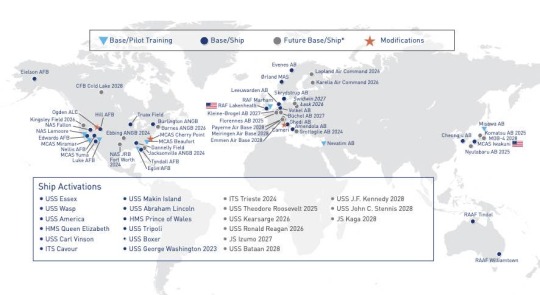
Current and expected future F-35 operating bases/ships. Lockheed Martin
Demand for the F-35 has never been higher. Recent geopolitical events and shifting threats have spiked orders. For newer customers or existing ones that are ordering more jets, getting TR-3 jets and potentially Block 4 capabilities will be of significant value. They will be receiving a far more mature aircraft and one with drastically expanded capabilities and growth potential than past versions.
Block 4 will include many new features, including much-expanded processing power, new displays, enhanced cooling, new EOTS and DAS electro-optical sensors, and a slew of additional weapons that will really unlock the F-35's potential. Above all else, the jet's new radar and electronic warfare suite should give it its biggest boost. The electronic warfare aspect alone is the biggest advantage Block 4 will bring, according to the Air Combat Command's top uniformed officer.

Some of the unclassified upgrades are expected to be part of Block 4. The exact configuration is not publicly disclosed just yet. DOD
The current issue is that F-35s need a new hardware backbone and associated baseline software, collectively called TR-3, to handle the various demands of the Block 4 upgrades. TR-3 has and continues to suffer numerous delays in its development.
The increasing age of the F-35 program's current fleet of test jets and other limitations in existing test infrastructure, especially with regard to software labs on the ground, have compounded these issues. The first flight of an F-35 test jet with a version of the TR-3 backbone took place in January 2023 and efforts are underway to create a dedicated TR-3 test force with a total of six Joint Strike Fighters.

A US Air Force F-35A test jet. USAF
As of December, the expectation is that the development of TR-3 will be finished sometime between April and June of this year, according to Defense News. If that schedule holds, this work be done between a year and 18 months later than expected.
The delays have also translated into significant added costs for the F-35 program. At a House Armed Services Committee hearing in December, Representative Donald Norcross, a Democrat from New Jersey, said that problems with TR-3 had led to a $1 billion cost overrun. The full estimated cost of the F-35 program though the end of its expected lifecycle in the 2070s is currently pegged around around $1.7 trillion, according to the Government Accountability Office (GAO).

USAF
At the House Armed Services Committee hearing last month, Air Force Lt. Gen. Michael Schmidt, the current head of the F-35 Joint Program Office (JPO), seemed less than optimistic about the likelihood of there being no further TR-3 delays.
"Relative to the stability issues that were that we're seeing, we are working through them. ... I wish I had all of the solutions in place that prove to me that when I do something in the lab, it's going to show up that way in the air," Schmidt told the assembled legislators. "We have a number of fixes addressing the stability challenges. We will get to a stable, capable, maintainable airplane here."
However, "the data tells me it will be in the middle of spring, but I would have had a more positive answer six months ago ... so I don't have a super solid 'I can guarantee you this date,'" he added.
After the completion of the development of the TR-3 package, these improvements will still need to be integrated into existing jets. The F-35 program is separately pursuing upgrades to the Pratt & Whitney F135 engines that power all variants of the Joint Strike Fighter, as well as power and thermal management systems, which will also be critical for enabling Block 4 capabilities. The issues surrounding the F135 engine have become a very hot topic of debate.
youtube
In the meantime, the U.S. military has made clear that it will not accept any new F-35s until the TR-3 issues are ironed out. This is ostensibly because the necessary checkout flights cannot be conducted on the jets until the hardware and its core software work reliably.
So, for at least another few months, the 1,000th F-35, and many others, are set to stay parked away waiting for work on the core TR-3 upgrades to be finished.
Contact the author: [email protected]
25 notes
·
View notes
Text
Dominate Local Search with Richardson’s Leading SEO Company: SEO Reimagined
youtube
In today’s fast-paced digital world, your online presence is everything. Whether you're running a cozy boutique on Main Street or leading a cutting-edge tech startup in the Richardson Innovation Quarter, getting noticed online can make or break your success. That’s where SEO Reimagined steps in — a premier SEO company based in Richardson, Texas, dedicated to helping local businesses dominate search engine results and reach more customers right in their backyard.
Why SEO Matters More Than Ever Search engine optimization (SEO) isn’t just about stuffing keywords into your website or chasing Google’s ever-changing algorithm. It’s a strategic approach to increase your visibility when potential customers search for products or services like yours. With more people turning to Google to find local businesses, a strong SEO strategy is crucial — especially in a thriving city like Richardson, where competition can be fierce.
Consider this: 97% of people learn more about a local company online than anywhere else. If your business isn’t showing up in those top search results, you’re likely losing customers to competitors who are.
The Richardson Advantage – Go Local, Win Big Richardson is more than just a suburb of Dallas. It’s a bustling community known for its rich cultural diversity, high-tech economy, and supportive environment for entrepreneurs. From telecom giants and software developers to unique eateries and boutique shops, businesses here are as varied as the people they serve.
But with great opportunity comes the challenge of visibility. How do you make sure your business isn’t lost in the noise? By partnering with a reliable SEO company like SEO Reimagined, you’ll have the tools and expertise needed to rise to the top of local search results and stand out in your industry.
What Makes SEO Reimagined Different? At SEO Reimagined, we believe that SEO should be more than just technical jargon and generic strategies. We reimagine the SEO process to fit your business goals, your audience, and your local landscape. Here’s how we do it:
Local SEO Focused Our primary goal is to help Richardson businesses succeed locally. That means optimizing your Google Business Profile, targeting location-based keywords, earning high-quality local backlinks, and ensuring your name, address, and phone number (NAP) are consistent across all platforms.
Tailored SEO Strategies No two businesses are the same — and neither should their SEO strategies be. We take the time to understand your business, your competitors, and your customers before crafting a personalized SEO roadmap that aligns with your goals.
Transparent Reporting With SEO Reimagined, you’re never left in the dark. We provide clear, monthly reports that show real results — traffic growth, keyword rankings, conversion rates, and more — so you know exactly how your investment is paying off.
Content That Converts We create high-quality, keyword-rich content that not only ranks well but also speaks to your audience. Whether it’s blog posts, service pages, or FAQs, our content strategy is designed to attract, engage, and convert.
Ongoing Optimization SEO isn’t a one-time task — it’s an ongoing process. Our team continuously monitors your performance, adapts to algorithm changes, and refines your strategy to ensure you stay ahead of the competition.
Services Offered by SEO Reimagined We offer a full suite of SEO services tailored to help Richardson businesses succeed:
Local SEO Optimization – Get your business in front of nearby customers ready to buy.
On-Page SEO – We fine-tune your website’s structure, content, and metadata for peak performance.
Off-Page SEO – Boost your site’s authority through strategic link-building and online reputation management.
Technical SEO – From site speed to mobile responsiveness, we handle the backend optimizations that impact rankings.
Content Marketing – We craft SEO-friendly content that tells your story and builds trust with your audience.
Analytics and Reporting – Get clear insights into how your SEO is performing and where there’s room to grow.
Who We Work With Whether you're a new business trying to get noticed or an established brand looking to scale, SEO Reimagined is the SEO company Richardson businesses trust. We work with:
Local service providers (plumbers, electricians, landscapers)
Healthcare clinics and dental offices
Restaurants and coffee shops
Legal and financial professionals
E-commerce stores and online retailers
Startups and tech companies
The SEO Reimagined Promise We’re not just another SEO agency. We’re your partner in growth. When you work with us, you get more than rankings — you get real, measurable business results. Our team is passionate about helping Richardson businesses flourish in the digital age, and we’re committed to going above and beyond to help you succeed.
Ready to Grow? Let’s Talk If you're looking for a trustworthy, experienced SEO company in Richardson, Texas, SEO Reimagined is ready to help. We bring a local-first mindset, proven strategies, and a results-driven approach to every campaign. Let us help you turn online searches into real-world customers — and real growth for your business.

2 notes
·
View notes